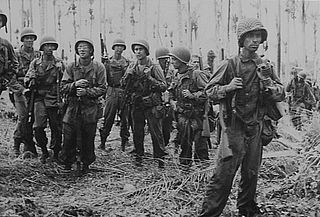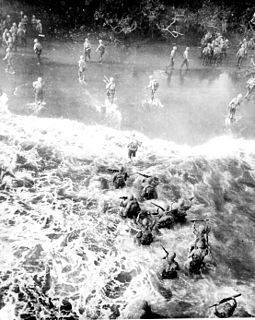
The 41st Infantry Division was composed primarily of National Guard units from Idaho, Montana, Oregon, North Dakota and Washington that saw active service in World War I and World War II. It was one of the first to engage in offensive ground combat operations during the last months of 1942. In 1965 it was reorganized as the 41st Infantry Brigade. The brigade has seen combat in the Iraq War in 2003 and 2008. Then again in Afghanistan in 2014.

USS Kilty (DD–137) was a Wickes-class destroyer in the United States Navy. She was the first ship named for Admiral Augustus Kilty.

The New Guinea campaign of the Pacific War lasted from January 1942 until the end of the war in August 1945. During the initial phase in early 1942, the Empire of Japan invaded the Australian-administered Mandated Territory of New Guinea and the Australian Territory of Papua and overran western New Guinea, which was a part of the Netherlands East Indies. During the second phase, lasting from late 1942 until the Japanese surrender, the Allies—consisting primarily of Australian and US forces—cleared the Japanese first from Papua, then the Mandate and finally from the Dutch colony.

The New Britain campaign was a World War II campaign fought between Allied and Imperial Japanese forces. The campaign was initiated by the Allies in late 1943 as part of a major offensive which aimed to neutralise the important Japanese base at Rabaul, the capital of New Britain, and was conducted in two phases between December 1943 and the end of the war in August 1945.
USS PC-1119 was a PC-461-class submarine chaser built for the United States Navy during World War II. She was later renamed Greencastle (PC-1119), after Greencastle, Indiana and Greencastle, Pennsylvania, but never saw active service under that name.

The Battle of Cape Gloucester was fought in the Pacific theater of World War II between Japanese and Allied forces on the island of New Britain, Territory of New Guinea, between 26 December 1943 and 16 January 1944. Codenamed Operation Backhander, the US landing formed part of the wider Operation Cartwheel, the main Allied strategy in the South West Pacific Area and Pacific Ocean Areas during 1943–1944. It was the second landing the US 1st Marine Division had conducted during the war thus far, after Guadalcanal. The objective of the operation was to capture the two Japanese airfields near Cape Gloucester that were defended by elements of the Japanese 17th Division.

The Battle of Biak was part of the Western New Guinea campaign of World War II, fought between the United States Army and the Japanese Army from 27 May to 17 August 1944. Taking place on the island of Biak, in Geelvink Bay, in present-day Indonesia, it was part of General Douglas MacArthur's Southwest Pacific Command's offensive drive to clear New Guinea in preparation for an invasion of the Philippines. It was the first major effort by the Japanese to allow uncontested landings for the purpose of creating a kill zone inland. The main Allied objective was to capture the island so that they could construct airfields there. The battle resulted in the capture of the island by Allied forces, which were then used to support operations elsewhere in the Pacific.

The Battle of Driniumor River, also known as The Battle of Aitape, 10 July – 25 August 1944, was part of the Western New Guinea campaign of World War II. Japanese forces attacked United States forces on the Driniumor River, near Aitape in New Guinea. The battle should not be confused with Operation Persecution, which included amphibious landings near Aitape in April 1944, or the Aitape-Wewak campaign, which began in November. The Japanese referred to the Driniumor as the Hanto.

The Markham and Ramu Valley – Finisterre Range campaign, was a series of actions in the New Guinea campaign of World War II. The campaign began with an Allied offensive in the Ramu Valley, from 19 September 1943, and concluded when Allied troops entered Madang on 24 April 1944. During the campaign, Australian forces – supported by Australian and US aircraft – advanced through the Markham and Ramu Valleys during which there were minor clashes with Japanese forces, which withdrew towards their main defensive line in the Finisterre Range. The central geographical and strategic feature of the campaign was the imposing Shaggy Ridge, running north–south in the Finisterres; this was the scene of a climactic battle during which the Australians assaulted the Japanese positions in December 1943 and January 1944. Following the fighting around Shaggy Ridge, the Japanese withdrew towards the northern coast of New Guinea, where they were pursued by Australian and US forces advancing through the Finisterres and along the coast from Saidor. Following the capture of Madang, the Japanese eventually withdrew to Wewak where further fighting took place in 1944 and 1945.

The Western New Guinea campaign was a series of actions in the New Guinea campaign of World War II. Dutch East Indies KNIL, United States and Australian forces assaulted Japanese bases and positions in the northwest coastal areas of Netherlands New Guinea and adjoining parts of the Australian Territory of New Guinea. The campaign began with Operations Reckless and Persecution, which were amphibious landings by the U.S. I Corps at Hollandia and Aitape on 22 April 1944. Fighting in western New Guinea continued until the end of the war.

The Battle of Hollandia was an engagement between Allies of World War II and Japanese forces during World War II. The majority of the Allied force was provided by the United States, with the bulk of two United States Army infantry divisions being committed on the ground. Air and naval support consisted largely of U.S. assets, although Australia also provided air support during preliminary operations and a naval bombardment force.

The Landing at Aitape was a battle of the Western New Guinea campaign of World War II. American and Allied forces undertook an amphibious landing on 22 April 1944 at Aitape on northern coast of Papua New Guinea, as part of Operations Reckless and Persecution. The amphibious landing was undertaken simultaneously with the landings at Humboldt and Tanahmerah Bays to secure Hollandia to isolate the Japanese 18th Army at Wewak. Operations in the area to consolidate the landing continued until 4 May, although US and Japanese forces fought further actions in western New Guinea following a Japanese counter-offensive that lasted until early August 1944. Aitape was subsequently developed into an Allied base of operations and was used by Australian forces throughout late 1944 and into 1945 during the Aitape–Wewak campaign.

The Aitape–Wewak campaign was one of the final campaigns of the Pacific Theatre of World War II. Between November 1944 and the end of the war in August 1945, the Australian 6th Division, with air and naval support, fought the Imperial Japanese 18th Army in northern New Guinea. Considered a "mopping up" operation by the Australians, and although ultimately successful for them with the Japanese forces cleared from the coastal areas and driven inland, amidst difficult jungle conditions, casualties from combat and disease were high. With Japan on the verge of defeat, such casualties later led to the strategic necessity of the campaign being called into question.

The Japanese 18th Army was a field army of the Imperial Japanese Army during World War II.

The Battle of Noemfoor was a battle of World War II that took place on the island of Noemfoor, in Dutch New Guinea, between 2 July and 31 August 1944. United States and Australian forces attacked to capture Japanese bases on the island.

The Battle of Morotai, part of the Pacific War, began on 15 September 1944, and continued until the end of the war in August 1945. The fighting started when United States and Australian forces landed on the southwest corner of Morotai, a small island in the Netherlands East Indies (NEI), which the Allies needed as a base to support the liberation of the Philippines later that year. The invading forces greatly outnumbered the island's Japanese defenders and secured their objectives in two weeks. Japanese reinforcements landed on the island between September and November, but lacked the supplies needed to effectively attack the Allied defensive perimeter. Intermittent fighting continued until the end of the war, with the Japanese troops suffering heavy loss of life from disease and starvation.

The Battle of Lone Tree Hill, is the name given to a major battle in 1944 in Dutch New Guinea, between United States and Japanese forces.

The Battle of Wakde(Operation Straight Line) was part of the New Guinea campaign of World War II. It was fought between the United States and Japan from 18 May 1944 to 21 May 1944 in Dutch New Guinea. The operation involved an assault on the Japanese-held Wakde island group by a reinforced US infantry battalion, which was transported from a beachhead the Allied troops had established around Arara, on the mainland, the previous day. Following the capture of the island, fighting on the mainland continued until September as Allied troops advanced west towards Sarmi. In the aftermath, the island's airbase was expanded and used to support operations around Biak and in the Marianas.

The Battle of Madang, fought between early February and late April 1944, was the break-out and pursuit phase of the Markham and Ramu Valley – Finisterre Range and Huon Peninsula campaigns, which were part of the wider New Guinea campaign of World War II. After overcoming the Japanese defences around Shaggy Ridge, the Australian forces descended the steep slopes of the Finisterre Range and pursued the withdrawing Japanese towards Bogadjim and then Madang on the north coast of New Guinea. There they linked up with US and Australian forces that had advanced along the coast from the Huon Peninsula, while the remnants of three Japanese divisions withdrew towards Wewak, where further fighting would take place throughout late 1944 and into 1945.

USS LST-22 was a United States Navy LST-1-class tank landing ship used exclusively in the Asiatic-Pacific Theater during World War II and staffed by a United States Coast Guard crew. Like many of her class, she was not named and is properly referred to by her hull designation.


















